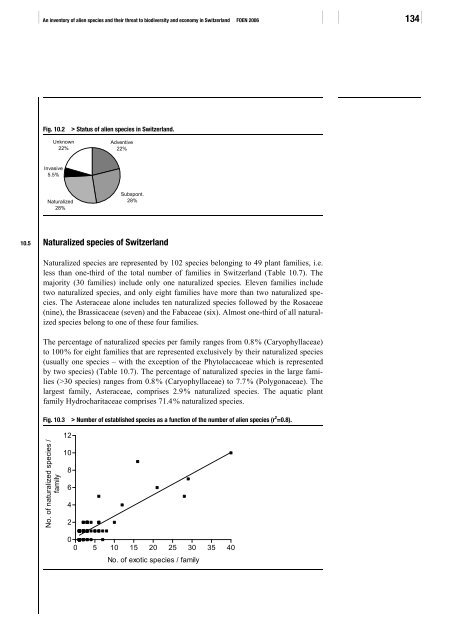Invasive alien species in Switzerland - Schweizer ...
Invasive alien species in Switzerland - Schweizer ...
Invasive alien species in Switzerland - Schweizer ...
You also want an ePaper? Increase the reach of your titles
YUMPU automatically turns print PDFs into web optimized ePapers that Google loves.
An <strong>in</strong>ventory of <strong>alien</strong> <strong>species</strong> and their threat to biodiversity and economy <strong>in</strong> <strong>Switzerland</strong> FOEN 2006 134<br />
Fig. 10.2 > Status of <strong>alien</strong> <strong>species</strong> <strong>in</strong> <strong>Switzerland</strong>.<br />
Unknown<br />
22%<br />
<strong>Invasive</strong><br />
5.5%<br />
Naturalized<br />
28%<br />
Adventive<br />
22%<br />
Subspont.<br />
28%<br />
10.5 Naturalized <strong>species</strong> of <strong>Switzerland</strong><br />
Naturalized <strong>species</strong> are represented by 102 <strong>species</strong> belong<strong>in</strong>g to 49 plant families, i.e.<br />
less than one-third of the total number of families <strong>in</strong> <strong>Switzerland</strong> (Table 10.7). The<br />
majority (30 families) <strong>in</strong>clude only one naturalized <strong>species</strong>. Eleven families <strong>in</strong>clude<br />
two naturalized <strong>species</strong>, and only eight families have more than two naturalized <strong>species</strong>.<br />
The Asteraceae alone <strong>in</strong>cludes ten naturalized <strong>species</strong> followed by the Rosaceae<br />
(n<strong>in</strong>e), the Brassicaceae (seven) and the Fabaceae (six). Almost one-third of all naturalized<br />
<strong>species</strong> belong to one of these four families.<br />
The percentage of naturalized <strong>species</strong> per family ranges from 0.8 % (Caryophyllaceae)<br />
to 100 % for eight families that are represented exclusively by their naturalized <strong>species</strong><br />
(usually one <strong>species</strong> – with the exception of the Phytolaccaceae which is represented<br />
by two <strong>species</strong>) (Table 10.7). The percentage of naturalized <strong>species</strong> <strong>in</strong> the large families<br />
(>30 <strong>species</strong>) ranges from 0.8 % (Caryophyllaceae) to 7.7 % (Polygonaceae). The<br />
largest family, Asteraceae, comprises 2.9 % naturalized <strong>species</strong>. The aquatic plant<br />
family Hydrocharitaceae comprises 71.4 % naturalized <strong>species</strong>.<br />
Fig. 10.3 > Number of established <strong>species</strong> as a function of the number of <strong>alien</strong> <strong>species</strong> (r 2 =0.8).<br />
No. of naturalized <strong>species</strong> /<br />
family<br />
12<br />
10<br />
8<br />
6<br />
4<br />
2<br />
0<br />
0 5 10 15 20 25 30 35 40<br />
No. of exotic <strong>species</strong> / family
















